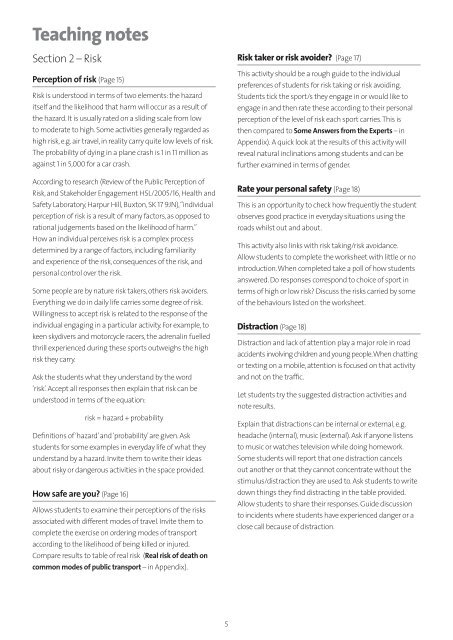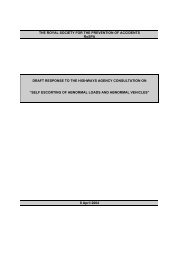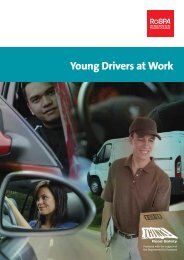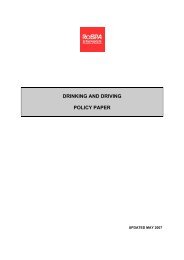Travel training - Key Stages 3 and 4 - RoSPA
Travel training - Key Stages 3 and 4 - RoSPA
Travel training - Key Stages 3 and 4 - RoSPA
You also want an ePaper? Increase the reach of your titles
YUMPU automatically turns print PDFs into web optimized ePapers that Google loves.
Teaching notes<br />
Section 2 – Risk<br />
Perception of risk (Page 15)<br />
Risk is understood in terms of two elements: the hazard<br />
itself <strong>and</strong> the likelihood that harm will occur as a result of<br />
the hazard. It is usually rated on a sliding scale from low<br />
to moderate to high. Some activities generally regarded as<br />
high risk, e.g. air travel, in reality carry quite low levels of risk.<br />
The probability of dying in a plane crash is 1 in 11 million as<br />
against 1 in 5,000 for a car crash.<br />
According to research (Review of the Public Perception of<br />
Risk, <strong>and</strong> Stakeholder Engagement HSL/2005/16, Health <strong>and</strong><br />
Safety Laboratory, Harpur Hill, Buxton, SK 17 9JN), “individual<br />
perception of risk is a result of many factors, as opposed to<br />
rational judgements based on the likelihood of harm.”<br />
How an individual perceives risk is a complex process<br />
determined by a range of factors, including familiarity<br />
<strong>and</strong> experience of the risk, consequences of the risk, <strong>and</strong><br />
personal control over the risk.<br />
Some people are by nature risk takers, others risk avoiders.<br />
Everything we do in daily life carries some degree of risk.<br />
Willingness to accept risk is related to the response of the<br />
individual engaging in a particular activity. For example, to<br />
keen skydivers <strong>and</strong> motorcycle racers, the adrenalin fuelled<br />
thrill experienced during these sports outweighs the high<br />
risk they carry.<br />
Ask the students what they underst<strong>and</strong> by the word<br />
‘risk’. Accept all responses then explain that risk can be<br />
understood in terms of the equation:<br />
risk = hazard + probability<br />
Definitions of ‘hazard’ <strong>and</strong> ‘probability’ are given. Ask<br />
students for some examples in everyday life of what they<br />
underst<strong>and</strong> by a hazard. Invite them to write their ideas<br />
about risky or dangerous activities in the space provided.<br />
How safe are you? (Page 16)<br />
Allows students to examine their perceptions of the risks<br />
associated with different modes of travel. Invite them to<br />
complete the exercise on ordering modes of transport<br />
according to the likelihood of being killed or injured.<br />
Compare results to table of real risk (Real risk of death on<br />
common modes of public transport – in Appendix).<br />
Risk taker or risk avoider? (Page 17)<br />
This activity should be a rough guide to the individual<br />
preferences of students for risk taking or risk avoiding.<br />
Students tick the sport/s they engage in or would like to<br />
engage in <strong>and</strong> then rate these according to their personal<br />
perception of the level of risk each sport carries. This is<br />
then compared to Some Answers from the Experts – in<br />
Appendix). A quick look at the results of this activity will<br />
reveal natural inclinations among students <strong>and</strong> can be<br />
further examined in terms of gender.<br />
Rate your personal safety (Page 18)<br />
This is an opportunity to check how frequently the student<br />
observes good practice in everyday situations using the<br />
roads whilst out <strong>and</strong> about.<br />
This activity also links with risk taking/risk avoidance.<br />
Allow students to complete the worksheet with little or no<br />
introduction. When completed take a poll of how students<br />
answered. Do responses correspond to choice of sport in<br />
terms of high or low risk? Discuss the risks carried by some<br />
of the behaviours listed on the worksheet.<br />
Distraction (Page 18)<br />
Distraction <strong>and</strong> lack of attention play a major role in road<br />
accidents involving children <strong>and</strong> young people. When chatting<br />
or texting on a mobile, attention is focused on that activity<br />
<strong>and</strong> not on the traffic.<br />
Let students try the suggested distraction activities <strong>and</strong><br />
note results.<br />
Explain that distractions can be internal or external, e.g.<br />
headache (internal), music (external). Ask if anyone listens<br />
to music or watches television while doing homework.<br />
Some students will report that one distraction cancels<br />
out another or that they cannot concentrate without the<br />
stimulus/distraction they are used to. Ask students to write<br />
down things they find distracting in the table provided.<br />
Allow students to share their responses. Guide discussion<br />
to incidents where students have experienced danger or a<br />
close call because of distraction.

















